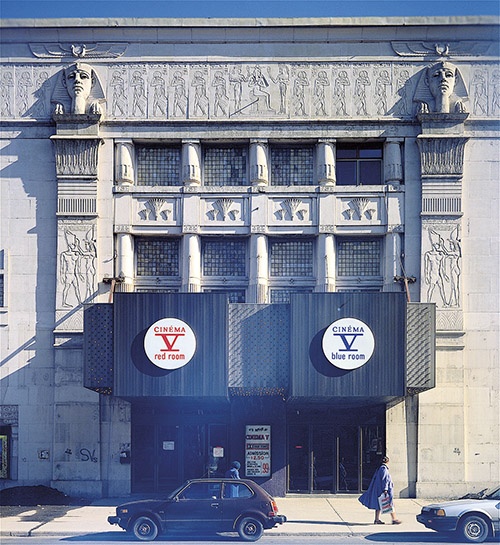 Sandra Cohen-Rose/Flickr
Sandra Cohen-Rose/Flickr
Cinema V
When I was eleven, my father was given an envelope of free tickets to Cinema V, the repertory theatre a couple of blocks away from where we lived in Notre-Dame-de-Grâce. The cinema’s building had Egyptian figures carved into the relief, and two columns with the heads of pharaohs on top. In 1984, this was where cool kids hung out. The guys dressed in second-hand suit jackets over Talking Heads t-shirts and Converse sneakers. The girls wore heavy black eyeliner as though they were members of Andy Warhol’s Factory. I preferred their outfits to the preppy St. Elmo’s Fire aesthetic that was mainstream at the time; those young people went to the mainstream theatre to watch Tom Cruise, Kevin Costner and Meg Ryan be American.
There were two screening rooms in Cinema V: the Red Room and the Blue Room. The Red Room was more traditional. It had plush velvet chairs and a heavy red curtain that opened up before the film started. This was where they played newer releases, the ones that were too controversial or art house to have runs in regular theatres.
The Blue Room was where I found myself on my first visit and most other days I went. It was larger but much more run-down. It looked like a rough draft of a cinema. The carpets were dirty and threadbare. The seats were leather with wooden backs, often broken and mostly light blue. There was a filthy barren stage in front of the screen.
In the middle of Repo Man, the first film I saw there, a member of the audience climbed up on the stage and began acting out the motions of a character. No one seemed to find it odd. During a scene where the main character drops his pants, the entire audience screamed, “Give him a blow job!” I was startled and had no idea what was going on, but I survived the film and loved it.
I kept going back. You could tell from the way the crowd was dressed whether there was a cult classic playing that night. The stage was an invitation for someone to run up and begin acting out a scene from the movie. They would be shot like the character and find themselves writhing on the floor, or laugh maniacally like the psychopath projected above. Terrified at first, I grew to love this breaking of the fourth wall.
Even when I ran out of free tickets, I kept returning. I’d seen teenagers sneak in by climbing up the fire escape on the side of the building and entering through an emergency exit near the roof. But I kept paying the child’s fare—ninety-nine cents if you were eleven or under—until I was fourteen and five-foot-ten. The people who worked there were so laid back, they never said anything about it.
I had a wild education in films at Cinema V. By the time I was thirteen, I’d seen virtually every Nouvelle Vague film, every Italian realist masterpiece and all the American classics from the 1970s. I learned about eccentric dialogue, about profundity and horror and abjection, about the sublime and the unspeakable. I learned about auteur cinema and distinctive voice. The theatre taught me to look for art outside of the mainstream and to appreciate works no one else around me could stand.
When I learned that Cinema V was closing in 1988, I joined a group of teenagers protesting outside of the theatre. It didn’t work, of course. For a brief time it became a regular movie theatre, and then, after a fire in 1992, the building lay deteriorating for decades. There were attempts to resurrect the space and turn it into a community hub or arts centre, but the plans came to naught, and the building was finally condemned.
The magic of Cinema V was created out of a benevolent neglect, a group of talented programmers and a mob of curious young adults looking for knowledge about subcultures, punk sensibilities and DIY aesthetics. No logical or political planning could ever recreate that. Now the building stands empty, filled with the ghosts of rebellious teenagers. The pharaohs look ahead, not reporting their crimes. ⁂
Heather O’Neill lives and writes in Montreal.





